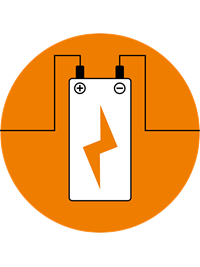Modern vehicles have a high energy demand. This means it’s important to make sure that the battery has plenty of power during diagnosis. In this chapter of my blog, I will explain how it works and what you need to consider.
You might remember the VW Golf Mk2 or Golf Mk3: you could keep the ignition on for a relatively long time without the starter battery running out of juice. This luxury no longer exists in cars today. During measurement or calibration, you need to make sure that battery voltage doesn't drop below 12.2 - 12.4 volts. If not, the vehicles communication system may refuse to work. This can be really frustrating if you are in the middle of a calibration or just want to check the fault memory. Also, low power can cause unnecessary faults to appear, particularly communication faults, which can muddy the waters.
 Starting problems and low voltages are handled by the battery management system. Modern vehicles are "smart", so individual systems in the car have different priority levels when it comes to power supply. As an example, if the voltage drops too low, the brake light will have priority over something like the air conditioning, because it's far more important that it works correctly.
Starting problems and low voltages are handled by the battery management system. Modern vehicles are "smart", so individual systems in the car have different priority levels when it comes to power supply. As an example, if the voltage drops too low, the brake light will have priority over something like the air conditioning, because it's far more important that it works correctly.
To ensure a stable power supply, use a battery maintenance device that supplies at least 30 amps of power. The more power the charger offers, the better. Also, make sure that the charger supports all types of batteries, like liquid, gel, or AGM.
Today, most vehicles are fitted with AGM batteries. AGM stands for "Absorbent Glass Mat". In AGM batteries the electrolyte is bound in a glass mat. Along with an increased contact pressure on the plus and minus plates, this gives a higher cycle stability. This can produce a charge that is up to three times higher. With the now widespread start-stop systems, an AGM battery has become indispensable.
How to Connect the Charger to a Battery Management System
Before you start an input diagnosis, connect a suitable battery maintenance device. This saves time and money. If sporadic faults are displayed in the fault memory, you can at least be sure that it was not caused by the power supply.
Make sure that the negative terminal of the battery maintenance device is connected to the service port provided and not directly to the negative pole of the battery. The service port is always located directly on the body in the engine compartment at a specified earth point. The battery sensor, on the other hand, is always located directly on the negative pole of the battery. If we connected the negative terminal directly to the negative pole, we would bypass the sensor and suspend its function. This would mean that, in case of a problem, that the electronic control unit needs to be reset or, in the worst case, the vehicle will not start again.